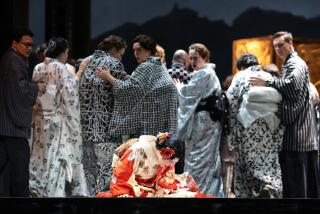Opera : Verdi’s ‘Aida’ Lumbers Back to Orange County
- Share via
COSTA MESA — Opera Pacific was never what one would call an adventurous company. Still, David DiChiera and friends used to take an occasional cautious step away from the so-called standard repertory. Not this year.
The season opened Saturday night with Verdi’s “Aida,” just as it had--under better conditions--in 1988. Other beloved, emphatically familiar warhorses monopolize the horizon at the Performing Arts Center: “La Traviata” in January, “Madama Butterfly” and “The Magic Flute” in March. The modest survey of French masterpieces has been put on hold, and the 20th Century remains uncharted territory in deepest, darkest Orange County.
Ah, economy.
The pain of hyper-timidity might have been mitigated, to a degree, by a brilliant inaugural performance. But this “Aida”--gaudily decorated, clumsily staged and badly sung--didn’t even come close. The push-button cheers of the dressy, not-too-attentive first-nighters were inspired, no doubt, by Verdi, not by his local violators.
The most impressive aspect of the production, for better or worse, involved Douglas Schmidt’s lavish, fussy, cumbersome, pretty-pretty sets, designed for a staging by Sam Wanamaker at the San Francisco Opera in 1981. With their constantly rearranged, constantly glowing pillars, their endlessly ornate frippery indulgences and pompously portentous statues, the designs suggest nothing so much as quaint illustrations from a very old edition of the Victor Book of the Opera. Memphis, Thebes and the Pharaohs looked a lot better here six years ago in the spacious, stylized decors of Wolfram Skalicki.
The costumes seen on Saturday, attributed to Lawrence Casey, look like the result of an indiscriminate warehouse raid. Aida self-consciously modeled a thigh-baring sarong (her alternate in the role, who can conjure no images of Dorothy Lamour, must wear something else). The princess Amneris strutted her ample stuff in voluminous evening gowns. The others settled for generic postcard-exotica.
Although Ross A. Perry was listed as stage director, he functioned essentially as traffic cop. Given the hand-me-down Vegas ambience, principals culled mostly from the stand-and-lurch school of operatic acting and a chorus that seemed reluctant to move and sing at the same time, one couldn’t blame him.
No one bumped into anyone, and no one fell down. Even though a man-drawn chariot began its exit in the Triumphal Scene before discharging its heroic passenger, there were no obvious accidents. One had to be grateful.
John DeMain conducted with stoic rigidity, unfazed, it would seem, by the silliness on the stage, by the inequities in the pit, by the chatter out front, by the tenor’s rhythmic liberties, by the soprano’s limited breath, by the mezzo’s pitch problems, by the baritone’s wobble under pressure or by the chorus’ instability. At the very least, this maestro has strong nerves.
Kevin Bell brought a firm, resonant, pliant basso to the brief rantings of the high priest of Egypt. Unfortunately, when the best singer in the cast is Ramfis, you know the cast shouldn’t be singing “Aida.”
Maria Guleghina, a Bolshoi Aida in the agonized Vishnevskaya tradition, cut an appealing figure in her tight little spangly dress and bare feet, though crawling on her knees in the Nile Scene represented something of a challenge. Her big, bright and sometimes beautiful soprano encountered difficulties with the arching line, however, and her ability to float ethereal pianissimo tones proved unreliable. Like many a Verdian slave before her, she nearly came to grief on the cruelly exposed C that caps “O patria mia.”
Lando Bartolini partnered her as a loud, crude and apparently bored Radames whose chief distinction seemed to be the highest elevator-shoes this side of Giulietta Simionato.
Tichina Vaughn introduced a loud, dull and shrill Amneris who began to take measure of this great challenge at the end of the Judgment Scene. Too late.
Robert McFarland, the visually imposing Amonasro, seemed to be yet another lyric baritone straining to sound dramatic. The effort doesn’t augur well for his future.
Terry Cook as the woolly-toned king, Anita Protich as the invisible priestess and Christopher Campbell as the fleeting messenger did what they could. In context, it wasn’t much.
Lula Washington provided some unintentionally hilarious, anti-musical choreography, dutifully executed by members of her L.A. Contemporary Dance Theatre. In place of “the sacred dance of the priestesses,” she mustered a beefcake routine for a tall fellow in a golden jockstrap and, echoing James Penrod’s dubious work for the Costa Mesa class of ‘88, an utterly irrational human-sacrifice pantomime. These inspirations, it should be remembered, embellished a scene for which the composer specifically demanded “all the solemnity and weight possible.”
All in all, this was poor Verdi.
Poor Verdi.
* “Aida,” presented by Opera Pacific at the Orange County Performing Arts Center, 600 Town Center Drive, Costa Mesa. $18 - $85, at box office and commercial agencies (TicketMaster (714) 740-2000). Remaining performances with opening-night cast: Wednesday and Saturday at 8 p.m.; with Camellia Johnson (Aida), Eugenie Grunewald (Amneris) and Vladimir Popov (Radames) on Friday at 8 p.m. and Sunday at 2 p.m.
More to Read
The biggest entertainment stories
Get our big stories about Hollywood, film, television, music, arts, culture and more right in your inbox as soon as they publish.
You may occasionally receive promotional content from the Los Angeles Times.










